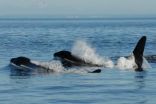(Press-News.org) Researchers have identified a set of three genes that are responsible for hybrid sterility in rice, or the inability of many hybrid rice species to pass their genes on to the next generation. These findings inform a model that suggests how such hybrid sterility is maintained across rice species, and they may lead to the genetic improvement of rice as a food stock.
The research is published in the 14 September issue of the journal Science, which is published by AAAS, the nonprofit science society.
When two different species mate, like a horse and a donkey, their hybrid offspring—a mule in this example—is born reproductively sterile. But, this phenomenon, known as hybrid sterility, isn't limited to the animal kingdom: Plenty of plants produce viable hybrids that are genetic dead-ends as well.
Now, Jiangyi Yang and colleagues from Huazhong Agricultural University in Wuhan, China, along with other researchers from the Chinese University of Hong Kong, have investigated the hybrid sterility that results between the indica and japonica subspecies of the cultivated rice, Oryza sativa.
The researchers honed in on a specific region of the rice chromosome, S5, which they had previously associated with hybrid sterility. They found three tightly linked genes—ORF3, ORF4, and ORF5—that control fertility in indica-japonica rice hybrids. The ORF5 gene functions as a killer and ORF4 partners with it while ORF3 works against them, taking on the role of a protector, they say.
Apparently, among indica and japonica subspecies of cultivated rice, the killer gene and its partner work together to kill female gametes, or eggs, while the protector gene actively tries to save them. Specifically, the researchers suggest that ORF5 produces a molecule that is sensed by ORF4 and leads to an uptick in stress on a cell's endoplasmic reticulum. That stress eventually activates ORF3, which works to stabilize and protect the endoplasmic reticulum, they say.
This kind of killer-protector system underlies the hybrid sterility between these two species of cultivated rice, according to the study. Yang and the other researchers suggest that non-lethal combinations of ORF4 and ORF5 may allow indica-japonica hybrids to pass their genes on to subsequent generations—and that overcoming this hybrid sterility in rice could lead to more desirable crops in the future.
INFORMATION:
The report by Yang et al. was supported by grants from the National Natural Science Foundation, the 863 Project, and the 111 Project of China. D.S. Brar of the International Rice Research Institute provided the rice seeds.
The American Association for the Advancement of Science (AAAS) is the world's largest general scientific society, and publisher of the journal, Science as well as Science Translational Medicine and Science Signaling. AAAS was founded in 1848, and includes some 261 affiliated societies and academies of science, serving 10 million individuals. Science has the largest paid circulation of any peer-reviewed general science journal in the world, with an estimated total readership of 1 million. The non-profit AAAS is open to all and fulfills its mission to "advance science and serve society" through initiatives in science policy; international programs; science education; and more. For the latest research news, log onto EurekAlert!, www.eurekalert.org, the premier science-news Web site, a service of AAAS.
Genes render some rice species sterile
System of 3 genes prevents hybrid rice from reproducing, new study shows
2012-09-14
ELSE PRESS RELEASES FROM THIS DATE:
How fast can ice sheets respond to climate change?
2012-09-14
BUFFALO, N.Y. -- A new Arctic study in the journal Science is helping to unravel an important mystery surrounding climate change: How quickly glaciers can melt and grow in response to shifts in temperature.
According to the new research, glaciers on Canada's Baffin Island expanded rapidly during a brief cold snap about 8,200 years ago. The discovery adds to a growing body of evidence showing that ice sheets reacted rapidly in the past to cooling or warming, raising concerns that they could do so again as the Earth heats up.
"One of the questions scientists have been ...
How early social deprivation impairs long-term cognitive function
2012-09-14
Boston, Sept. 13, 2012-- A growing body of research shows that children who suffer severe neglect and social isolation have cognitive and social impairments as adults. A study from Boston Children's Hospital shows, for the first time, how these functional impairments arise: Social isolation during early life prevents the cells that make up the brain's white matter from maturing and producing the right amount of myelin, the fatty "insulation" on nerve fibers that helps them transmit long-distance messages within the brain.
The study also identifies a molecular pathway ...
'Mini' stroke can cause major disability, may warrant clot-busters
2012-09-14
A transient ischemic attack, TIA or a "mini stroke," can lead to serious disability, but is frequently deemed by doctors too mild to treat, according to a study in the American Heart Association journal Stroke.
"Our study shows that TIA and minor stroke patients are at significant risk of disability and need early assessment and treatment," said Shelagh Coutts, M.D., lead author of the study at Foothills Hospital in Calgary, Alberta, Canada. "We should be imaging patients earlier and be more aggressive in treating patients with thrombolysis if we can see a blockage no ...
Long menopause allows killer whales to care for adult sons
2012-09-14
VIDEO:
This shows southern resident killer whales in the waters around the San Juan Islands, USA and British Columbia. Both male and female killer whales will remain with their mothers throughout...
Click here for more information.
Scientists have found the answer to why female killer whales have the longest menopause of any non-human species - to care for their adult sons. Led by the Universities of Exeter and York and published in the journal Science (14 September 2012) ...
Low cost design makes ultrasound imaging affordable to the world
2012-09-14
An ultra-low cost scanner that can be plugged into any computer or laptop to reveal vital information about the unborn child has been developed by engineers at Newcastle University, UK.
The hand-held USB device – which is roughly the size of a computer mouse – works in a similar way to existing ultrasound scanners, using pulses of high frequency sound to build up a picture of the unborn child on the computer screen.
However, unlike the technology used in most hospitals across the UK costing anywhere from £20,000-£100,000, the scanner created by Jeff Neasham and Research ...
Stress breaks loops that hold short-term memory together
2012-09-14
MADISON -- Stress has long been pegged as the enemy of attention, disrupting focus and doing substantial damage to working memory — the short-term juggling of information that allows us to do all the little things that make us productive.
By watching individual neurons at work, a group of psychologists at the University of Wisconsin–Madison has revealed just how stress can addle the mind, as well as how neurons in the brain's prefrontal cortex help "remember" information in the first place.
Working memory is short-term and flexible, allowing the brain to hold a large ...
Scripps Research scientists reveal how deadly virus silences immune system
2012-09-14
LA JOLLA, CA, September 13, 2012--Scientists at The Scripps Research Institute have determined the structure of a critical protein from the Marburg virus, a close cousin of Ebola virus. These viruses cause similar diseases and are some of the deadliest pathogens on the planet, each killing up to 90 percent of those infected.
Described in the September 13, 2012 publication of the journal PLoS Pathogens, the new research reveals how a key protein component of the Marburg virus, called VP35, blocks the human immune system, allowing the virus to grow unchecked. The structure ...
Neural implant recovers ability to make decisions
2012-09-14
Researchers have taken a key step towards recovering specific brain functions in sufferers of brain disease and injuries by successfully restoring the decision-making processes in monkeys.
By placing a neural device onto the front part of the monkeys' brains, the researchers, from Wake Forest Baptist Medical Centre, University of Kentucky and University of Southern California, were able to recover, and even improve, the monkeys' ability to make decisions when their normal cognitive functioning was disrupted.
The study, which has been published today, 14 September, in ...
Charting the SH2 pool
2012-09-14
New research published in BioMed Central's open access journal Cell Communication and Signaling describes a large set of interactions (interactome) which maps the range of phosphotyrosine (pTyr)-dependent interactions with SH2 domains underlying insulin (Ins), insulin-like growth factor-1 (IGF-1) and fibroblast growth factor (FGF) signaling pathways.
In the control of cell signaling pathways SH2 domains can be thought of as a master connector and tyrosine kinases the switch. SH2 domains interact with phosphorylated tyrosine containing peptides on receptors and other ...
Met Office model to better predict extreme winters
2012-09-14
Severe UK winters, like the 'big freeze' of 2009/10, can now be better forecast months in advance using the Met Office's latest model, new research suggests.
A new study, published today, Friday 14 September, in IOP Publishing's journal Environmental Research Letters, compares the latest seasonal forecast system to the one previously used and shows that it can better warn the UK of extreme winter weather conditions.
Dubbed the 'high-top' system, it is different from the previous system as it takes into account phenomenon known as sudden stratospheric warmings (SSWs), ...
LAST 30 PRESS RELEASES:
Colliding galaxies create the brightest, fastest growing black holes at their center
New BrainHealth research reveals tradeoffs on sleep with cannabis use for chronic pain
Aging-US now on ResearchGate, enhancing visibility for authors and readers
'Molecular glue' stabilizes protein that inhibits development of non-small cell lung cancer
Mount Sinai Health System is recognized in 2025 Chime Digital Health Most Wired survey
From prey to predator: How carnivores spread beneficial fungi
Menopause symptoms may be frequent and have negative effects, according to female endurance athletes
US Congressmembers’ responses on X to mass shooting events differ along party lines
KAIST-UEL team develops “origami” airless wheel to explore lunar caves
Individual genetic differences render some therapies ineffective
Engineering dendritic cells boosts cancer immunotherapy
Sophisticated neuroimaging reveals PTSD in WTC responders is linked to measurable physical changes in brain structure
Health policy experts identify promising strategies for providing health care to homeless people
Study explores role of neutrophils in canine atopic dermatitis
Mayo Clinic researchers develop AI-ECG model to diagnose liver disease earlier
Heavy menstruation common among teenage girls – questionnaire reveals risk of iron deficiency
New study explores why open water swimming feels so powerful for midlife women
In echo of Jurassic Park, mosquitoes capture entire ecosystems in their blood meals
Marty Cooper, Illinois Tech Alumnus and ‘Father of the Cell Phone,’ Receives 2025 Marconi Society Lifetime Achievement Award
How to reduce the risk of lymphedema
NEJM Evidence and CIDRAP announce Public Health Alerts
New fossil study illuminates on the evolutionary success of frogs
Patient-specific human liver model to understand disease mechanisms
Confused by the doctor's questionnaire? U of A study suggests it's common
How do brains stay stable, and when might a dose of flexibility be helpful?
mRNA revitalizes aging immune systems—the liver as a fountain of youth
Rural-urban differences in the prevalence of chronic pain among adult cancer survivors
Food insecurity, burnout, and social isolation among resident and fellow physicians
How do spinal cord injuries heal?
Detailed cell map unlocks secrets of how reproductive organs form
[Press-News.org] Genes render some rice species sterileSystem of 3 genes prevents hybrid rice from reproducing, new study shows



